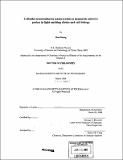| dc.contributor.advisor | Moungi G. Bawendi. | en_US |
| dc.contributor.author | Huang, Hao, Ph. D. Massachusetts Institute of Technology | en_US |
| dc.contributor.other | Massachusetts Institute of Technology. Dept. of Chemistry. | en_US |
| dc.date.accessioned | 2008-12-11T18:22:58Z | |
| dc.date.available | 2008-12-11T18:22:58Z | |
| dc.date.copyright | 2008 | en_US |
| dc.date.issued | 2008 | en_US |
| dc.identifier.uri | http://hdl.handle.net/1721.1/43760 | |
| dc.description | Thesis (Ph. D.)--Massachusetts Institute of Technology, Dept. of Chemistry, 2008. | en_US |
| dc.description | Vita. | en_US |
| dc.description | Includes bibliographical references. | en_US |
| dc.description.abstract | This thesis employs colloidal semiconductor nanocrystals (NCs) as nanoscale emissive probes to investigate the physics of light emitting diodes (LEDs), as well as to unveil properties of cells that conventional imaging techniques cannot reveal. On the LED side, in particular, Chapter 2 utilizes individual NCs to alter layered organic LED structures at nanometer scale, resulting in spectrally resolved electroluminescence from single colloidal CdSe/ZnS (core/shell) NCs at room temperature. Chapter 3 takes NCs as emissive probes in layered organic LEDs, and shows that the photoluminescence of single NCs is bias dependent which helps elucidate the interactions between NCs and organic semiconductors, knowledge useful for designing efficient NC organic optoelectronics. Instead of using a planar LED geometry, Chapter 4 presents a technique for making nanoscale gap LEDs which allow the spectrally coincidental photoluminescence and electroluminescence from NCs. The work investigates the interactions between NCs and different metal gaps, and suggests electromigrating leads made of different metals as a promising route to fabricating nanoscale gaps with workfunction offsets for optoelectronic devices. On the cell biology side, we develop a three-dimensional sub-diffraction limited single fluorophore imaging method for proteins labeled with NCs. Chapter 5 applies the method to measure the endothelial glycocalyx thickness in vitro for the first time, by labeling different proteins with NCs of different emission wavelengths. Taking a step further, Chapter 6 utilizes the NC based imaging method to investigate the flow induced dynamics of endothelial glycocalyx, and measures the shear modulus of glycocalyx. | en_US |
| dc.description.statementofresponsibility | by Hao Huang. | en_US |
| dc.format.extent | 178 p. | en_US |
| dc.language.iso | eng | en_US |
| dc.publisher | Massachusetts Institute of Technology | en_US |
| dc.rights | M.I.T. theses are protected by
copyright. They may be viewed from this source for any purpose, but
reproduction or distribution in any format is prohibited without written
permission. See provided URL for inquiries about permission. | en_US |
| dc.rights.uri | http://dspace.mit.edu/handle/1721.1/7582 | en_US |
| dc.subject | Chemistry. | en_US |
| dc.title | Colloidal semiconductor nanocrystals as nanoscale emissive probes in light emitting diodes and cell biology | en_US |
| dc.title.alternative | Colloidal semiconductor NCs as nanoscale emissive probes in LEDs and cell biology | en_US |
| dc.type | Thesis | en_US |
| dc.description.degree | Ph.D. | en_US |
| dc.contributor.department | Massachusetts Institute of Technology. Department of Chemistry | |
| dc.identifier.oclc | 259811003 | en_US |
